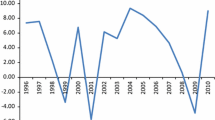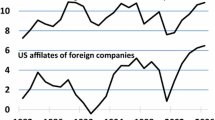Abstract
The “Internet Revolution” induced an unbalanced perspective on future economic growth strategies. Because information technology (IT) largely constitutes an infrastructure upon which other economic activity is based, its economic role is to facilitate the productivity of investment in a wide range of products and services that meet final demand. Other economies around the world can and are investing in the same infrastructure, so the efficiency advantages now being realized by the U.S. economy will be fleeting unless U.S. R&D efforts produce a new and broad range of innovative products and services that take advantage of this infrastructure. A deep and diverse technology-based manufacturing sector must be a core objective of a national R&D strategy. United States’ manufacturing contributes $1.5 trillion to GDP, employs 20 million workers, accounts for more than 70% of industrial R&D, and constitutes the main source of technology for the larger service sector. While knowledge-based services are the largest source of economic growth for the U.S. economy, their long-term performance is highly dependent on synergies with a domestic manufacturing sector. These synergies will be even more important in the future because services are increasingly exposed to foreign competition. Knowledge-based services can be supplied from anywhere in the world—as long as these foreign sources can rapidly access and assimilate the necessary technology components. This caveat is the critical point for economic growth policy. Considerable research supports the argument that hardware and software components are most efficiently supplied to services by a manufacturing sector that is geographically close and institutionally integrated with the service applications. Policy debates have raged for decades over the nature and magnitude of underinvestment in manufacturing R&D. The need to resolve the relevant policy issues has increased, as industry is funding less of the long-term, high-risk research that creates the technology platforms supporting new industries and future economic growth. Unfortunately, only about a third of U.S. manufacturing is high-tech by conventional definitions. Some of the remaining industries develop technologies internally, but most purchase a large proportion of their technology from the high-tech sector. Because a technology acquisition strategy can be more easily imitated by foreign competitors, traditional industries are much more susceptible to exchange rate variations, global economic cycles, and secular shifts in foreign competition. Thus, with global technological capabilities relentlessly increasing, the long-term prospects for the moderate and low R&D-intensive portions of U.S. manufacturing are not good. This paper presents a conceptual framework and available data as inputs for the analysis of Federal R&D investment strategies. Such strategies must recognize the full range of public and private technology assets constituting a national innovation system. A developed and efficient innovation system has characteristics making imitation by foreign competitors difficult and thereby enables sustained competitive advantage.
Similar content being viewed by others
References
Acs, Z., D. Audretsch, and M. Feldman, 1994, ‘R&D Spillovers and the Recipient Firm Size,’ Review of Economics and Statistics 76(2), 336-340.
American Electronics Association, 1997, Cybernation, Washington, DC: The American Electronics Association.
Ansley, M., 2000, ‘Virtual Manufacturing,’ CMA Management (February), 31-35.
Audretsch, D. and M. Feldman, 1996, ‘R&D Spillovers and the Geography of Innovation and Production,’ American Economic Review 86(3), 630-640.
Bean, A., J. Russo, and R. Whiteley, 2000, ‘Benchmarking Your R&D: Results from IRI/CIMS Annual R&D Survey for FY '98,’ Research & Technology Management 43(1) (Jan.–Feb.), 16-24.
Bennof, R. and S. Payson, 2000, ‘States Vary Widely in Their Rates of R&D Growth,’ Data Brief, Arlington, VA: National Science Foundation.
Besanko, D., D. Dranove, and M. Shanely, 1996, Economics of Strategy, New York: John Wiley.
Blair, M. and T. Kochan, 2000, ‘Introduction,’ in Blair and Kochan (eds.), The New Relationship: Human Capital in the American Corporation, Washington, DC: Brookings Institution.
Boskin, M. and L. Lau, 2000, ‘Generalized Solow-Neutral Technical Progress and Postwar Economic Growth,’ NBER Working Paper No. W8023 (December).
Brunnermeier, S. and S. Martin, 1999, Interoperability Cost Analysis of the U.S. Automotive Supply Chain (Planning Report 99-1), Gaithersburg, MD: National Institute of Standards and Technology (March).
Cameron, G., 1999, ‘R&D and Growth at the Industry Level,’ Nuffield College, Oxford, U.K. (http://hicks.nuff.ox.ac.uk/users/cameron/research/gpapers.html).
Cameron, G., 1998, ‘Innovation and Growth: A Survey of Empirical Evidence,’ Nuffield College, Oxford, U.K. (www.hicks.nuff.ox.ac.uk/users/cameron/research/gpapers.html).
Clampet, E., 1999, ‘Corporate Internet Spending Poised to Triple Soon', Internet News (February 23).
Cohen, L. and D. Levinthal, 1989, ‘Innovation and Learning: The Two Faces of R&D,’ Economic Journal 99 (September).
Corcoran, E., 1994, ‘The Changing Role of U.S. Corporate Research Labs,’ Research & Technology Management 37(4) (July–Aug.), 14-20.
David, P., B. Hall, and A. Toole, 2000, ‘Is Public R&D a Complement or Substitute for Private R&D? A Review of the Econometric Evidence,’ Research Policy 29 (April), 497-529.
Department of Commerce, 1998, The Emerging Digital Economy, Washington, DC: U.S. Department of Commerce (April).
Duga, J., 1994, IRI Forecast Reflects Major Change in How U.S. Industry Will Perform R&D,’ Research & Technology Management 37(3) (May–June), 9-11.
Enterprise Integration Council, 2000, http://www.eicouncil.org/eic-faq.html.
Feldman, M., 1994, The Geography of Innovation, Dordrecht, The Netherlands: Kluwer Academic Publishers.
Finan, W., 1997, Metrology-Related Costs in the U.S. Semiconductor Industry, 1990, 1996, and 2001 (NIST Planning Report 98-4), Gaithersburg, MD: National Institute of Standards and Technology (May).
Fingleton, E., 1999, In Praise of Hard Industries, Haslett, MI: Buttonwood Press.
Gallaher, M., A. O'Conner, and B. Kropp, 2002, The Economic Impact of Role-Based Access Control, (NIST Planning Report 02-01), Gaithersburg, MD: National Institute of Standards and Technology (February).
Gallaher, M. and S. Martin, 2000, Benefit Analysis of IGBT Power Device Simulation Modeling (Planning Report 99-3), Gaithersburg, MD: National Institute of Standards and Technology.
Geppert, L., 1994, ‘Industrial R&D: The New Priorities,’ IEEE Spectrum (September), 30-41.
Gordon, R., 1999, ‘Has the ‘New Economy’ rendered the Productivity Slowdown Obsolete?’ Working paper, Northwestern University and the National Bureau of Economic Research (June).
Gordon, R., 2000, ‘Does the ‘New Economy’ Measure Up to the Great Inventions of the Past?’ Journal of Economic Perspectives (Fall).
Griffith, R., S. Redding, and J. Van Reenen, 1998, ‘Productivity Growth in OECD Industries: Identifying the Role of R&D, Skills, and Trade,’ Institute for Fiscal Studies, London.
Griliches, Z., 1988, ‘Productivity Puzzles and R&D: Another Non-explanation,’ Journal of Economic Perspectives 2, 9-21.
Hicks, D., A. Breitzman, Sr., K. Hamilton, and F. Narin, 2000, ‘Research Excellence and Patented Innovation,’ Science and Public Policy 27(5), 310-320.
Iansiti, M. and J. West, 1997, ‘Technology Integration: Turning Great Research into Great Products,’ Harvard Business Review 75(3) (May–June), 69-79.
Industrial Research Institute, 1999, ‘Industrial Research Institute's R&D Trends Forecast for 1999,’ Research & Technology Management 42(1) (Jan.–Feb.), 19-23.
Industrial Research Institute, 2000, ‘Industrial Research Institute's R&D Trends Forecast for 2000,’ Research & Technology Management 43(1) (Jan.–Feb.), 11-15.
Jaffe, A., M. Trajtenberg, and R. Henderson, 1993, ‘Geographic Localization of Knowledge Spillovers as Evidenced by Patent Citations,’ Quarterly Journal of Economics 108(3), 577-598.
Jones, C. and J. Williams, 2000, ‘Too Much of a Good Thing?: The Economics of Investment in R&D,’ Journal of Economic Growth 5 (March), 65-85.
Jones, C. and J. Williams, 1998, ‘Measuring the Social Returns to R&D,’ Quarterly Journal of Economics 113 (November), 1119-1135.
Jorgenson, D., 2001, ‘U.S. Economic Growth I the Information Age', Issues in Science and Technology (Fall), 42-50.
Kash, D. and R. Rycroft, 1998, ‘Technology Policy in the 21st Century: How Will We Adapt to Complexity?’ Science and Public Policy 25(2) (April).
Keller, W., 2000, Geographic Localization of International Technology Diffusion, (Working Paper 7509), Cambridge, MA: National Bureau of Economic Research.
Kim, W.C. and R. Mauborgne, 1997, ‘Value Innovation: The Strategic Logic of High Growth', Harvard Business Review 75(1) (January–February), 102-112.
Klein, S. and N. Rosenberg, 1986, ‘An Overview of Innovation,’ in R. Landau and N. Rosenberg (eds.), The Positive Sum Strategy: Harnessing Technology for Economic Growth, Washington, DC: National Academy Press.
Lerner, J., 1996, The Government as Venture Capitalist: The Long-Run Impact of the SBIR Program, (Working Paper 5753), Cambridge, MA: National Bureau of Economic Research.
Link, A. N. and J. T. Scott, 1998, Public Accountability: Evaluating Technology-Based Institutions, Norwell, MA: Kluwer.
Manufacturing Institute, 1999, Facts About Modern Manufacturing, Washington, DC: The National Association of Manufacturers.
McAfee, A., 2000 ‘Economic Impacts of the Internet Revolution: Manufacturing,’ paper presented at the Brookings Institution/Department of Commerce conference on ‘The E-Business Transformation: Sector Developments and Policy Implications' (September 26).
McMillan, G.S., F. Narin, and D.L. Deeds, 2000, ‘An analysis of the Critical Role of Public Science in Innovation: The Case of Biotechnology,’ Research Policy 29(1) (January), 1-8.
Martin, S., M. Gallaher, and A. O'Conner, 2000, Economic Impact of Standard Reference Materials for Sulfur in Fossil Fuels (NIST Planning Report 00-1), Gaithersburg, MD: National Institute of Standards and Technology.
Marx, M., J. Scott, and S. Fry, 2000, Economic Impact Assessment: NIST-EEEL Laser and Fiberoptic Power and Energy Calibration Services (NIST Planning Report 00-3), Gaithersburg, MD: National Institute of Standards and Technology.
Narin, F., K. Hamilton, and D. Olivastro, 1997, ‘The Increasing Linkage Between U.S. Technology and Public Science,’ Research Policy 26(3) (December), 317-330.
National Research Council, 1999, Funding a Revolution: Government Support for Computing Research, Washington, DC: National Academy Press.
National Science Board, 2000, Science and Engineering Indicators—2000, Arlington, VA: National Science Foundation (NSB-00-1).
National Science Foundation, 2000, National Patterns of R&D Resources: 2000, Early Release Tables (http://www.nsf.gov/sbe/srs/srs01401/start.htm).
OECD, 2000, A New Economy?: The Changing Role of Innovation and Information Technology in Growth, Paris: Directorate for Science, Technology and Innovation
Office of Technology Assessment, 1995, Innovation and Commercialization of Emerging Technology, Washington, DC: U.S. Government Printing Office (September).
Oliner, S. and D. Sichel, 2000, The Resurgence of Growth in the Late 1990s: Is Information Technology the Story? Washington, DC: Federal Reserve Board.
Porter, M., 2000, ‘Location, Competition, and Economic Development: Local Clusters in a Global Economy,’ Economic Development Journal 14, 15-34.
Porter, M. and D. van Opstal, 2001, U.S. Competitiveness 2001: Strengths, Vulnerabilities and Innovation Priorities, Washington, DC: Council on Competitiveness.
Rice, M., G. O'Conner, L. Peters, and J. Morone, 1998, ‘Managing Discontinuous Innovation,’ Research & Technology Management 41(3) (May–June), 52-58.
Romer, P., 2000, Should the Government Subsidize Supply or Demand for Scientists and Engineers? (Working Paper 7723), Cambridge, MA: National Bureau of Economic Research.
Rosenberg, N., 1982, Inside the Black Box: Technology and Economics, New York: Cambridge University Press.
Stern, S., M. Porter, and J. Furman, 2000, The Determinants of National Innovative Capacity (Working Paper 7876), Cambridge, MA: National Bureau of Economic Research (September).
Studt, T. and J. Duga, 2000, ‘Industry Spends Big on Development While Feds Focus on Research,’ R&D Magazine Online (www.rdmag.com/features/0100forecastforecast.htm)
Tassey, G., 1995, ‘Encouraging Long-Range Research,’ ISSUES in Science and Technology (Fall), 31-33.
Tassey, G., 1996, ‘Choosing Government R&D Policies: Tax Incentives vs. Direct Funding,’ Review of Industrial Organization 11, 579-600.
Tassey, G., 1997, The Economics of R&D Policy, Westport, CT: Quorum Books.
Tassey, G., 1999a, ‘Lessons Learned about the Methodology of Economic Impact Studies: The NIST Experience,’ Evaluation and Program Planning 22, 113-119.
Tassey, G., 1999b, R&D Trends in the U.S. Economy: Strategies and Policy Implications (NIST Planning Report 99-2), Gaithersburg, MD: National Institute of Standards and Technology (April).
Tassey, G., 2003, Methods for Assessing the Economic Impacts of Government R&D (NIST Planning Report 03-1), Gaithersburg, MD: National Institute of Standards and Technology (September).
Whang, K., 1998–1999, ‘Fixing the Research Credit,’ ISSUES in Science and Technology 15 (Winter), 71-74.
Author information
Authors and Affiliations
Rights and permissions
About this article
Cite this article
Tassey, G. Policy Issues for R&D Investment in a Knowledge-Based Economy. The Journal of Technology Transfer 29, 153–185 (2004). https://doi.org/10.1023/B:JOTT.0000019536.59816.ae
Issue Date:
DOI: https://doi.org/10.1023/B:JOTT.0000019536.59816.ae




